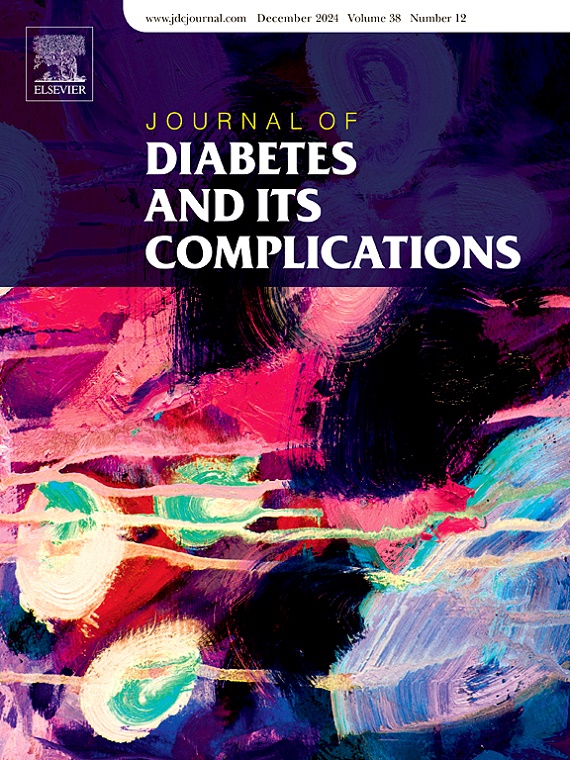Body-weight functional exercise promotes greater and safer blood glucose reduction compared to aerobic and strength exercises in type 1 diabetics: a randomised crossover study
IF 3.1
3区 医学
Q3 ENDOCRINOLOGY & METABOLISM
引用次数: 0
Abstract
Aims
Aerobic and strength exercises are commonly recommended for patients with type-1 diabetes (T1DM) but may not suit everyone. Body-weight functional exercise (BWFE) could offer an alternative for diabetes management. We aimed to compare blood glucose (BG), cardiovascular responses and enjoyment levels following a 30-min session of BWFE versus interval aerobic exercise (IAE) and strength exercise (STE) in patients with T1DM.
Methods
Ten T1DM participants (seven female) completed three randomised exercise sessions. BG, heart rate (HR), blood pressure (BP) and double product (DP) were measured before (PRE), immediately after (POST-0) and 20 min post-exercise (POST-20). Maximum and average HR were recorded, and enjoyment levels (EL) were assessed post-exercise. Statistical analysis used generalised estimated equations, with minimal detectable difference for assessing clinical significance.
Results
We observed clinically meaningful reductions in BG after all sessions, but only BWFE showed a statistically significant drop at POST-0 (−2.2 mmol/L) without hypoglycaemia. HR, BP and DP responses were similar across sessions. BWFE showed the highest EL and maximal HR.
Conclusions
BWFE effectively lowered BG safely and provided comparable cardiovascular effects to IAE and STE while being more enjoyable. These findings support incorporating functional exercises into T1DM management to encourage sustained physical activity.

与有氧运动和力量运动相比,体重功能运动在1型糖尿病患者中促进更大、更安全的血糖降低:一项随机交叉研究
有氧运动和力量运动通常推荐给1型糖尿病(T1DM)患者,但可能并不适合所有人。体重功能锻炼(BWFE)可以为糖尿病管理提供另一种选择。我们的目的是比较T1DM患者进行30分钟的BWFE与间歇有氧运动(IAE)和力量运动(STE)后的血糖(BG)、心血管反应和享受水平。方法10名T1DM参与者(7名女性)完成3个随机训练。分别在运动前(PRE)、运动后(POST-0)和运动后20分钟(POST-20)测量BG、心率(HR)、血压(BP)和双产物(DP)。记录最大和平均HR,并评估运动后的享受水平(EL)。统计分析使用广义估计方程,在评估临床意义时可检测到的差异最小。结果:我们观察到在所有疗程后,BG均有临床意义的降低,但只有BWFE在0后(- 2.2 mmol/L)无低血糖时显示有统计学意义的下降。HR、BP和DP的反应在不同的疗程中相似。BWFE表现出最高的EL和最大的HR。结论sbwfe安全有效地降低了BG,与IAE和STE相比具有相当的心血管效应,且更令人愉快。这些发现支持将功能锻炼纳入T1DM管理,以鼓励持续的身体活动。
本文章由计算机程序翻译,如有差异,请以英文原文为准。
求助全文
约1分钟内获得全文
求助全文
来源期刊

Journal of diabetes and its complications
医学-内分泌学与代谢
CiteScore
5.90
自引率
3.30%
发文量
153
审稿时长
16 days
期刊介绍:
Journal of Diabetes and Its Complications (JDC) is a journal for health care practitioners and researchers, that publishes original research about the pathogenesis, diagnosis and management of diabetes mellitus and its complications. JDC also publishes articles on physiological and molecular aspects of glucose homeostasis.
The primary purpose of JDC is to act as a source of information usable by diabetes practitioners and researchers to increase their knowledge about mechanisms of diabetes and complications development, and promote better management of people with diabetes who are at risk for those complications.
Manuscripts submitted to JDC can report any aspect of basic, translational or clinical research as well as epidemiology. Topics can range broadly from early prediabetes to late-stage complicated diabetes. Topics relevant to basic/translational reports include pancreatic islet dysfunction and insulin resistance, altered adipose tissue function in diabetes, altered neuronal control of glucose homeostasis and mechanisms of drug action. Topics relevant to diabetic complications include diabetic retinopathy, neuropathy and nephropathy; peripheral vascular disease and coronary heart disease; gastrointestinal disorders, renal failure and impotence; and hypertension and hyperlipidemia.
 求助内容:
求助内容: 应助结果提醒方式:
应助结果提醒方式:


